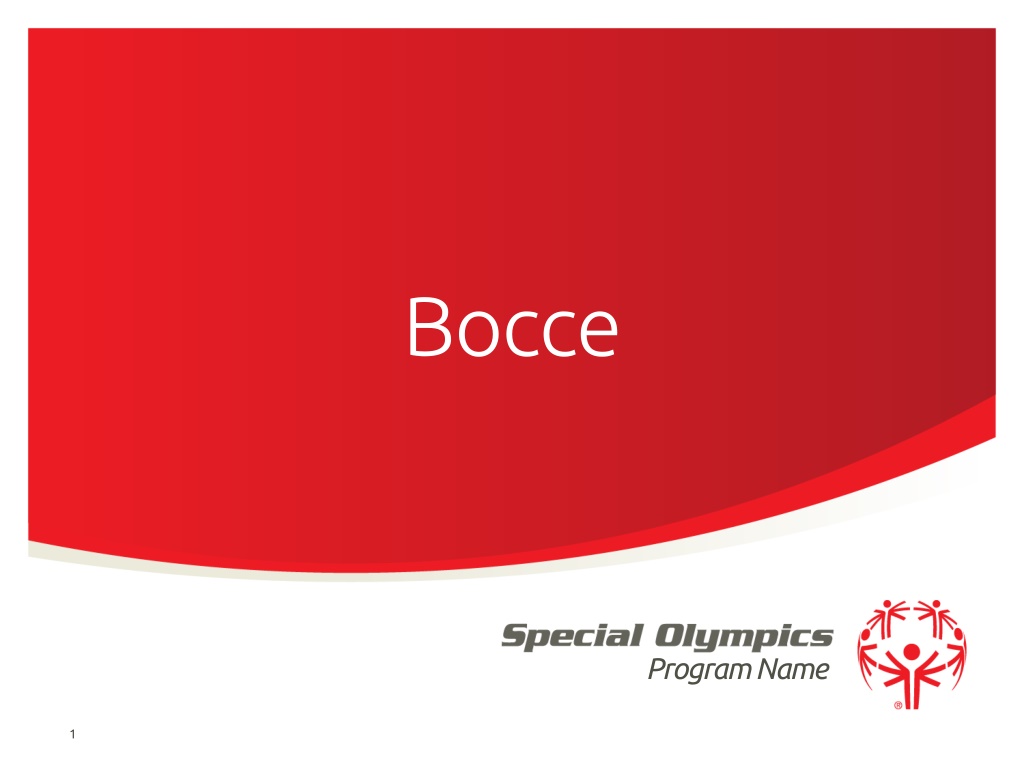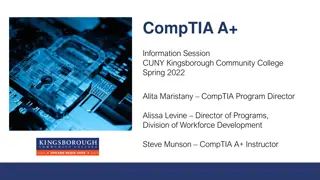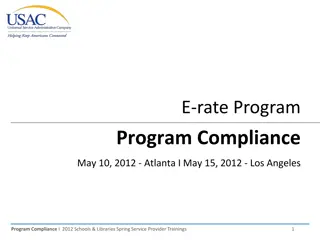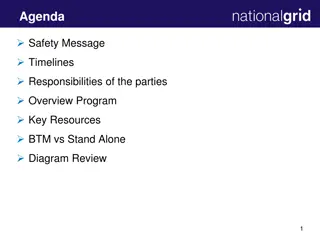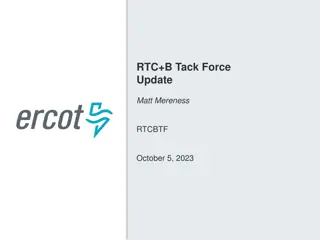Bocce Program Overview
The Bocce Program offers a variety of events including Singles, Doubles, Modified Singles, and Unified Sports Bocce for athletes participating in State Summer Games. Areas can enter up to 25% of their delegation in Bocce events, with athletes able to register for 1 or 2 events. The equipment used in Bocce consists of large balls and a smaller target ball called the pallina, with specific regulations on size and composition. The Bocce uniform requirements include white collared shirts or T-shirts, identical color and style for team members, closed-toed shoes, and prohibitions on jewelry and denim.
Download Presentation

Please find below an Image/Link to download the presentation.
The content on the website is provided AS IS for your information and personal use only. It may not be sold, licensed, or shared on other websites without obtaining consent from the author. Download presentation by click this link. If you encounter any issues during the download, it is possible that the publisher has removed the file from their server.
E N D
Presentation Transcript
Bocce Program Name 1
The Basics Sport season: April - June Culminating State Events: State Summer Games 2 / Special Olympics Program Name
Events Offered Singles Doubles Modified Singles Modified Doubles Unified Sports Bocce doubles (two players per team) Unified Sports Bocce Team (four players per team) 3
Specific Information 1. Each area may enter no more than 25% of their delegation in Bocce events. Athletes can register for 1 or 2 events. 2. Areas may have a pool (group) of alternates that may be interchangeable in their own area for more than one team. 4
Bocce Equipment Program Name 5
Bocce Equipment 1. The game bocce is played with eight large balls and one smaller target or object ball called the pallina. There are four balls to a side or team, and they are generally made in two colors to distinguish the balls of one team from the opposing team. The large balls are also inscribed with distinctive lines to identify the balls of the players on the same team. 2. Bocce balls may be composed of wood or composition materials and should be of equal size. Official league and tournament ball sizes may be from 107 mm (4.20") to 110 mm (4.33") and 2.0 to 2.25 lbs. weight. 3. The color of the balls is immaterial provided that the four balls of one team are clearly and visibly distinct from the four balls of the opposing team. 4. Pallina must not be larger than 63 mm (2-1/2") or smaller than 48 mm (1.875") and should be of a color visibly distinct from both bocce ball colors. 5. A measuring device may be any device that can accurately measure the distance between two objects and is acceptable to the tournament officials. 6. If an athlete is visually impaired a volunteer may hold a beeper near the pallina to identify its position during delivery. 7. Ramps may be used when an athlete does not have the physical ability to roll with their hand or hands. Ramps and other assistance devices may be used with the approval of the Competition Committee. No mechanical aids shall be used to propel the bocce ball or pallina. Athletes using ramps must be placed in separate divisions from other players only for singles competition. All other tournament rules shall apply to athletes in the ramp divisions. 6
Uniform Program Name 7
Bocce Uniform 1. The bocce uniform is a white collared shirt or a T- shirt and dress shorts/pants. 2. All members of the bocce team must wear shirts and shorts/pants that are identical in color and style 3. Closed toed shoes are recommended 4. Jewelry and denim are prohibited 8
Bocce Rules Program Name 9
General Bocce Rules 1. The number of points to win a game is 12. Games will conclude after 10 frames or 25 minutes, if 12 points isn t obtained. 2. No coaching is allowed from the sidelines 3. Three and four person single elimination with consolation game, brackets based on gender and score 4. Singles: player is allowed 4 balls, Doubles: player is allowed 2 balls 10
General Rules Cont. Sequence of play I. A coin toss by the referee will determine which team has the pallina and choice of ball color II. The pallina is rolled or tossed by a member of the team winning the coin toss III. The player who tosses the pallina, must follow up by delivering the first ball for their team. IV. The opposing team then delivers their bocce balls until the point is taken or they have exhausted their foul balls. This nearest ball rule governs the sequence of played balls V. The side whose ball is the closest to the pallina is called the in ball and the opposing side the out ball. Whenever a team is in , it steps aside and allows the out team to deliver. 3 attempt rule VI. The team possessing the pallina will have 3 attempts at placing the pallina within the 30 mark and before the 10 mark on the opposite end. If these 3 attempts are unsuccessful, the opposing team gets the chance to place the pallina. If this is unsuccessful within 3 attempts the referee will place the pallina. 11
General Rules Cont. Initial Point I. Ball Delivery The team with the pallina advantage has to establish the initial point I. A player has the option of rolling, tossing, bouncing, banking, etc. its ball down the court II. A player can spock or hit out any ball in play in trying to obtain a point or decrease the opponents score III. Ball delivery must be underhand IV. Bank or rebound shots are allowed off sideboards or backboards Rotation of Players I. The players of the team may elect to play their ball in any rotation, as long as the player who delivers the pallina tosses the first ball II. The rotation can vary to players discretion as long as no player delivers more than his/her allotted number of balls per frame 12
Scoring I. At the end of the frame, scoring is determined as follows: points are awarded to the team whose balls are closer to the pallina than the closest ball of the opposing team, which can be determined by viewing or mechanical measurements II. A player can request a mechanical measurement III. The referee announces the winning points and color at the end of the frame IV. The scoring team wins the pallina advantage for the next frame Ties I. In the event that the two balls closest to the pallina are from opposing teams, no points will be awarded and the frame will be replayed II. The pallina returns to the team which delivered it 13
Fouls Program Name 14
Bocce Fouls Foul Line Fouls I. In pointing and hitting, the foremost part of the specific foul-line will not be surpassed by any part of the foot before the ball leaves the player s hand II. All fouls must be called by a referee when the foul is witnessed; one official warning may be granted for each team after which penalties will be assessed III. The penalties will consist of a. The team fouled against will be awarded points as they were immediately preceding the foul; or b. The fouled against team has the option to decline the penalty and finish the frame Moving Ball or Pallina I. If a player delivers the ball before the pallina or previously delivered ball has come to a complete stop, the ball just delivered should be stopped by the referee if possible and declared a dead ball II. If the referee can t stop the ball before it reaches the balls in play , the referee shall remove the just delivered ball from the court and put the balls in play back to where they previously were 15 / Special Olympics Program Name
Bocce Fouls Cont. Playing Extra Ball i. When a player rolls an extra ball during a frame, the ball in question is declared dead ii. If possible the referee will seek to stop the extra ball before it reaches the pallina and balls in play: iii. If the extra ball played does come into contact with the pallina or balls in play the referee will move the balls back to where they were Illegal Movement of Your Ball: If a player moves one or more of his or her team s balls, the ball(s) are removed from the court and considered dead Illegal Movement of Opponents Ball: If, after all 8 balls have been thrown, a player moves an opponents ball, then for each ball moved the opposing team is awarded 1 point. If the opponent still has balls left to throw, then the referee shall move the balls back to where they were and remain playing Illegal Movement of Pallina: If the pallina is moved by a player, the opposite team will be awarded as many points as the number of live balls that were in contention plus the number of balls yet un-played. If the team fouled against has no balls in contention then the frame is dead 16
Bocce Fouls Cont. Accidental Movement of Balls by Referee i. During play: The frame is considered dead ii. Interference With a Ball in Motion After play: If points were obvious to the referee, they shall be awarded. If not obvious, the frame is dead I. By own team: The ball being thrown that was contacted is considered dead, if the dead ball touches balls in contention, the balls in contention are moved back II. By opponent: The team fouled against has three options: 1) play the ball over, 2) declare the frame dead, 3) decline the penalty accept the contacted ball where it lies and continue playing Wrong Color Ball Delivery I. If the ball is replaceable: The ball may not be stopped by another player or referee. Once the ball has stopped it shall be replaced with the proper color ball by the referee II. If the ball is not replaceable: The frame considered dead 17
Bocce Fouls Cont. Wrong Rotation of Play I. Initial Point: If the wrong team delivers the pallina and their first ball, the referee will hault play and restart the frame with the correct team throwing the pallina and ball II. Subsequent Rolls: If a player delivers their ball when their team is in and the other team has balls left, the ball in question should be stopped by the referee before it reaches the balls in contention , be declared dead and removed from play. If the ball reaches the balls in contention the referee shall replace the balls contacted nearest to where they were before the throw. 18
Modified Bocce Program Name 19
Modified Bocce Rules 1. Modified bocce is designed for the athlete who does not have the ability to consistently throw a 4-1/2" ball sixty feet for 10 frames. 2. Modified bocce singles and doubles will be played under the same rules as listed previously with the following changes: I. Play will only be in one direction. Volunteers will bring the balls back to the athletes. Volunteers may place the balls in the lap of the athlete (in the case of an athlete being in a wheelchair), but they may not, nor may a coach, assist in the throwing of any ball. II. The court size will be 30 feet in length and 12 feet in width. The court will be open (shaped like the letter "U") on one end. This opening will allow for the easy movement of wheelchair and severely physically-disabled athletes. III. The bocce balls may be 4" in diameter and are approximately 1 pound. IV. Three Attempt Rule - The team possessing the pallina will have 3 attempts at placing the pallina within the 10 mark and before the 5 mark on the opposite end. If these 3 attempts are unsuccessful, the opposing team will have one opportunity to place the pallina. If this attempt is unsuccessful, the referee will place the pallina in the center of the court width at the 15.24 m (5') mark (from the closed end). However, at no time does a team lose its earned pallina advantage of being able to deliver the first ball. After the above succession, the pallina shall not be touched. 20
Unified Bocce Program Name 21
Unified Bocce Rules 1. Unified Bocce is played as a doubles competition. Each Unified Sports doubles team shall consist of one athlete and one partner. 2. There is no requirement within these rules as to who (Athlete or Partner) plays the pallina and first bocce ball. The order can change from game to game or frame to frame. 3. Unified Bocce will follow the same rules as outlined previously with no changes to a typical doubles match. 22
Thank you. Program Name 23
